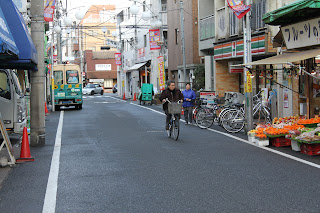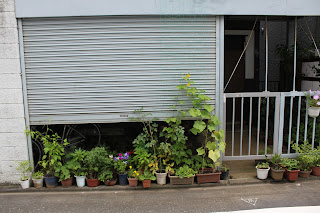Whilst I have a working theory about zen it is actually of no use to anyone else so it is pointless me talking about it here. Instead I want to talk about bicycles (not motorcycles you understand) and how they impact on the Tokyo consciousness. Oh, O.K., let's not try to make this grander than it really is, I just want to share my own prejudiced and biased insights into bicycles and try to spuriously attach whatever level of depth thinking I believe I can get away with. Obviously I have every faith in the readers to see through such arrogant nonsense.
Once you are in Tokyo there is a huge amount to see and take in but you have to be blind not to see all the bicycles everywhere. The pragmatic, efficient, healthy, ecologically sound, environmentally friendly bicycle has everything about it that fits into the contemporary Japanese psyche without even a whisper of objection. They even have a cultural history firmly within the annals of Japan.
Within every social image you will find two wheels good, four wheels bad, well you know what I mean by George. This mode of transport is highly favoured as being a very pragmatic solution to local transport issues.
There's an old bike, or even a new one, parked on every street, left in front of every shop and stacked in rows in every market. In Japan there are two business ventures I believe will set you up for life, one is umbrella manufacture and the other is anything to do with bicycles.
All ages use the bicycle and as regular readers will know, HMiL is an inveterate rider of this simple machine. The images you see are all in and around Mushashi Koyama, central Tokyo, and it really is no different anywhere else.
The school run is markedly different in Tokyo. 4x4 fuel guzzling selfish wealth displaying kid carts do not clog up the streets in the mornings and afternoons. Mothers load their kids onto bikes and peddle them to school. Just pause for a moment and think about this, consider all of the benefits to society this entails.
What is important in this social acceptance of the bicycle is safety. In Japan you ride bikes mostly on pavements. Everyone knows the sound of a bell tinkling behind them to make the pedestrian aware of the approach of a bike. More importantly everyone has a daughter, a mother or a grandmother who rides a bike, everyone knows how important it is to be safety conscious around bikes. Even when you ride them in the street the traffic still knows your vulnerability. In Japan there are rules and generally everyone obeys them. In Japan you can have bikes and traffic, you can have bikes and pedestrians and you can transport your children on bikes, in Japan the bicycle is a valued commodity for many, many reasons.
In the UK, nearly thirty years ago, a young Japanese woman was riding her bike around London when an articulated lorry turn left all over her. She was dragged under the wheels and was lucky to survive, she was desperately injured and bears the scars and trauma to this day. In many ways I feel this is an allegorical tale for Japanese people arriving in mid twentieth century London. God knows what they think of us, the dirt on the streets, the aggression on the trains [see Dee's Comment after Japanese Garden article] and the general lack of respect in society, I am sure there could be a healthy business in providing therapy to newly arrived Japanese who do not understand that they have not just travelled across the world but travelled way back in time.
In England you couldn't have the Japanese bike culture anymore than you could leave your garden pots lined up on the street against your house. No matter what we do our culture is stressed and under pressure. If you cannot see that then you have just been conditioned to bad behaviour as the norm.
Even taking a photograph without permission invokes a disapproving stare but it doesn't invoke a violent reaction or full on negative response. That look is enough but then again the photographer is a foreigner so what do you expect? He is not one of us, how would he know the rules, he probably doesn't even know how to ride a bike.
In the meantime if any of you want to buy gold or silver rather than leave your money in collapsing currencies and negative interest rate bank accounts then here is where you do it: Saving in Gold Alternatively you could simply believe what the politicians, bankers and economists are telling you, after all we all have to believe in something!

















































